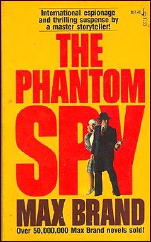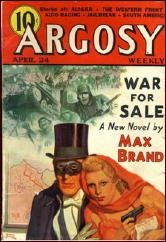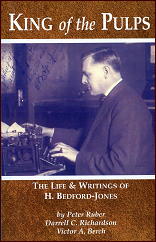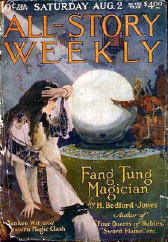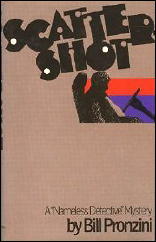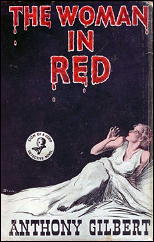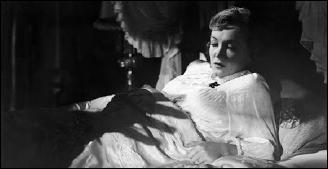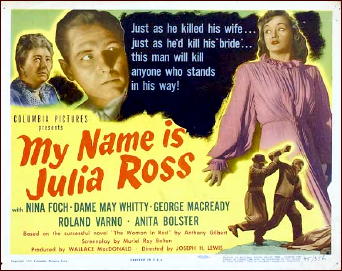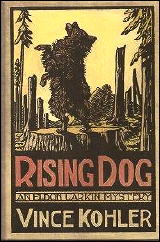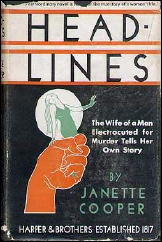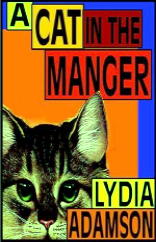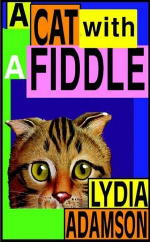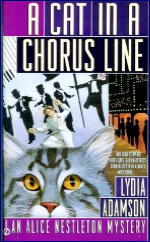Josef Hoffmann:
Two Crime Novels by RYERSON JOHNSON
Ryerson Johnson (1901-1995) is known primarily as an author of Westerns, but he also wrote numerous crime novels. Only two were published in his own name:
Naked in the Streets, Red Seal #10, Fawcett, 1952, cover art Carl Bobertz.
Lady in Dread, Gold Medal #459, Fawcett, 1955, cover art Barye Phillips.

Naked in the Streets begins like a noir novel. Herbert Hopson is employed in a company that manufactures perfume. On the way to work he is knocked from the sidewalk into the street by an unknown passerby and almost run over. He cannot believe that this happened intentionally. As he suffered a minor injury and tore his clothing in the fall, he returns home to change clothes.
A strange scene awaits him in his apartment. In the half-light his wife, Sybil, sits on a chair as if on a throne in an almost naked state, with a dog whip in her hand and stilettos on her feet. She is enraged at her husband because he has returned home unannounced. She explains the strange scene by claiming that she will be appearing at a charity bazaar as an animal trainer.
Hopson goes back to work wearing fresh clothes. There he behaves in such a provocative manner that he is fired instantly. He goes to a strip club to see Sally Dawn, whom he worships, stripping. During this time, a man seated in the seat in which Hopson should have been sitting is murdered. Hopson flees from the club and later returns to his apartment.
In an argument with Sybil he rips the clothes from her body, while she scratches his face. Whereas Hopson is ashamed, his wife is turned on by the violent behaviour and wants him to punish her with the whip. Her husband is disgusted and leaves the apartment in a state of shock. When he returns shortly afterwards in order to talk things through with her, she is dead, strangled.
Hopson fears that the police will not believe in his innocence, which is why he does not call them. He suspects that the murder is somehow connected to his wife’s double life. In the apartment he catches the scent of a perfume produced by his company that is still in the testing phase and which has not yet been released to the market.
For this reason Hopson suspects that someone from the company is involved in the murder plan. He sets off to find the suspects and to reveal the real murderers. In the process he is hunted by both the murderers and the police. He ends up in turbulent scenes, but he constantly finds people who trust him and help him. The story naturally includes a prostitute, who falls in love spontaneously with our hero and provides him with an alibi. And then of course there is also the mysterious Sally Dawn.
Although the story of Naked in the Streets is at times unrealistic and kitschy, the action is very varied and the dramaturgy of suspense is well done.
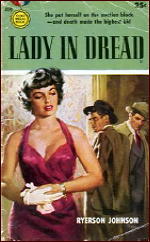
Already after reading the first two pages of Lady in Dread we know that the author has very clear ideas of Good and Evil, and where his position is in relation to each. The novel is set in Coalfield, a city to the south of Chicago, which has been dominated by gambling and crime since the decline of the coal-mining industry.
Tessie Cullen, a beautiful young woman, applies for a job as a “twenty-six girl†at a dice table in Farmer McGivern’s Top Money Tavern, and gets it. Farmer McGivern is one of the rulers of the city. A scene takes place every day at around the same time, opposite his gambling saloon, upon which the spectators place bets. A hawk sits on the flagpole of the courthouse and watches sparrows. Then, suddenly, it pounces on one of the sparrows and takes it as its prey. The spectators bet on the time of day at which the hawk carries out this act.
Hally Harper, a good-looking young lawyer, comes to Coalfield on behalf of an animal welfare organisation, in order to combat the betting spectacle. In reality, however, he is a narcotics officer pursuing a truckload of opium. The opium belongs to a Chicago gangster syndicate and was stolen in the vicinity of Coalfield. The syndicate has a premises in Coalfield, a glamorous nightclub with a casino at the city limits. It is trying to extend its influence over the city. The syndicate gets Tessie Cullen to spy on the Farmer, especially to see if he has claimed the opium.
There is yet a third party that also rules over Coalfield, the mayor. Which of the three parties has got hold of the opium delivery? Or is it a fourth, unknown entity? Harper tries to find out by questioning different people and searching for possible hiding places. In the process he whips up a storm and frequently ends up in danger of his life.
Tessie Cullen, who first tries to trap Harper on behalf of the Farmer, later joins his side. She asks Harper how he can be so ambivalent in the face of impending death.
The novel is varied and full of action, albeit rather conventional. A particular moment of tension is created by the fact that, while the hero and heroine act in a covert manner and are thus forced into falsifications and lies, they nevertheless try to maintain the core of their moral identity, in other words, to remain true to themselves. The narrative style tends towards hard-boiled, but not to noir fiction, as the protagonists are not subject to any calamitous fate. I always had a good feeling while reading the novel.
— Translated by Carolyn Kelly
